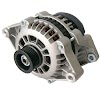What is the Working Principle of a Transformer ?
The transformer works on the principle of faraday's laws of electromagnetic indication. As the transformer is static device, the induction is static based on the concept of mutual induction. "whenever a conductor links the changing flux an E.m.f. is induced in that conductor". This induced E.m.f. is proportional to the rate of change of flux linkages and number of turns.
Concept of mutual induction
The E.m.f. induced in one coil due to the change of flux in neighboring coil is know as mutual induced E.m.f. and the phenomenon is known as "Mutual induction". consider two coil A and B wound on the iron core as show in fig. (a). coil A is connected across the A.C. supply and is known as primary winding. coil B is connected to the load and is know as secondary and is know as primary winding. When primary winding (coil A) is energized by A.C. supply voltage, the current in primary winding produces alternating flux (changing flux) in the core. This alternating flux passes through the core. when the secondary winding links with this change in flux. an e.m.f. is induced in the secondary winding according to faradays laws of electromagnetic induction. This e.m.f. is known as mutual induced e.m.f. The e.m.f. induced in the secondary winding causes a current through the load.
here, it is observed that, the A.C. supply is given to the primary winding, but an E.M.F. is induced in the secondary winding. This concept is known as mutual induction, which is a basic principle of working of a transformer. fing.1.1 (b) illustrates how the windings are wound over the iron core and how mutual induced E.M.F. is induced.










0 Comments